If you’re looking to advance your career while staying employed, understanding how long to stay in a role is essential. Not everyone needs or wants to start a business, and some careers thrive within traditional employment. Jobs like sales, financial advising, or legal services often offer high accountability and pay tied to results, which can create meaningful career opportunities without requiring self-employment.
But how long should you remain in the same role to maximize growth and experience? Let’s explore.
The Myth of “30 Years of Experience”
Early in my career, I encountered someone who had worked in the same role for 30 years. They claimed to have “30 years of experience,” but in reality, this often means decades spent doing the same tasks repeatedly. True experience involves diversity—challenging new roles, environments, and learning opportunities.
One employer shared a piece of wisdom that has stuck with me: “After two years, you’ve learned about 90% of a role.” While some additional learning happens after this point, the rate of growth often plateaus. Ideally, most professionals should aim to stay in a role for two to five years.
The Learning Curve and Career Growth
In your first two years, you gain most of your job-specific skills. By five years, the rate of learning slows dramatically. Staying beyond this point can stifle your growth. Instead of settling, consider:
- Changing roles within the same company.
- Moving to a new company for fresh challenges.
- Climbing the ladder into leadership roles.
- Pursuing a completely new career path.
Each new transition provides an opportunity to expand your skills, break out of your comfort zone, and accelerate personal development. The diagrams below illustrate how periodic career shifts can boost your trajectory compared to staying stagnant.
The first diagram below is helpful to explain how you learn 90% of a job in the first two years.
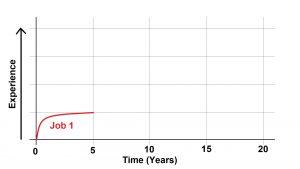
By the end of two years, you’ll have gained the majority of job-specific knowledge, and by five years, most of the meaningful learning will be complete. While learning continues after five years, the pace slows significantly and begins to plateau. Staying in the same role much longer often limits opportunities for personal growth and development.
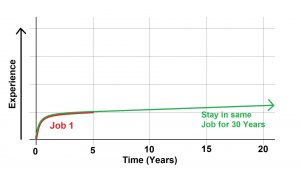
This contrasts sharply with my former colleague who stayed in the same position for 30 years. As shown in the next diagram, the learning curve flattens after five years, offering minimal new growth or experience. A better strategy is to make a change every few years—whether by switching roles, moving to a new company, pursuing higher positions, or even exploring a completely different career path.
The diagram below highlights how making a substantial change every five years can significantly boost your growth. Each transition, whether to a new role, position, or industry, introduces fresh challenges, skills, and environments. These changes create a spike in learning and development, breaking you out of your comfort zone and expanding your experience.
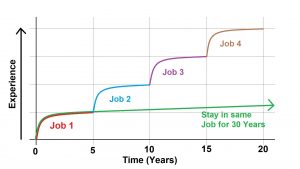
Overcoming Career Change Fears
Many people fear change due to risks like losing redundancy pay or taking a pay cut. While these are valid concerns, staying too long in a role limits both your learning and earning potential. At the end of the day, a job is just a job and you will only ever get paid just enough to make you turn up for more. In my experience, meaningful financial progress comes from taking calculated risks.
Promotions and pay raises for loyalty or hard work are often incremental. By contrast, switching jobs or roles can result in significant pay increases and professional growth.
Avoiding this change can sometimes be a form of procrastination, whether that be out of fear or not being sufficiently motivated to make the change. If this is the case, you simply have to overcome this challenge in order to progress.
Moving from Employed to Business in Four steps
At the time of creating the video on this topic, I was coaching two guys who are employed in the technology space. Both guys had a good job with a career ahead of them, but both of them wanted to leave employment and start a business. I used the diagram to explain the steps I would take if I was in their position.
It is important to note that the timescales for each role shown in the diagram below are a guide and that can and should be compressed where necessary. I actually took these same steps myself albeit in slightly different timescales for each.
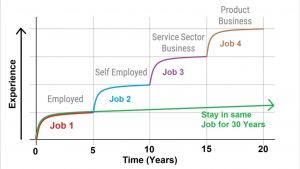
If your long-term goal is to transition from employment to owning a business, the following four steps can guide you:
-
Gain Five Years of Foundational Experience
Start in a role that allows you to learn from seasoned colleagues and tackle challenging projects. Large companies often provide structured environments ideal for acquiring diverse skills. -
Transition to Self-Employment
Use your experience to become a self-employed contractor. This step gives you more accountability, freedom, and higher earning potential. While some can skip directly to this stage, most need foundational experience to secure steady contract work. -
Scale to a Small Business
Move beyond solo work by hiring a team. This introduces leverage—scaling your output by delegating tasks to others. -
Build a Scalable Business
Shift from selling time to selling products or services. By leveraging technology and media, you can grow exponentially, selling more in less time. Examples include digital products, e-commerce, or subscription-based services.
Prioritising Learning Over Comfort
Staying in a role past the point of growth wastes valuable learning opportunities. Instead, design your career with self-development in mind. Whether you change companies, roles, or industries, aim to maximise your experiences.
While earning a stable income is a necessity for most, following the four steps above can help you balance financial stability with personal growth. When possible, prioritise projects and roles that challenge you, align with your long-term goals, and position you for greater opportunities in the future.
Take Action
“You don’t have to be great to start, but you have to start to be great.”
~ Zig Ziglar
Avoid falling into the tenure trap. Whether it’s a new role, company, or career path, bold decisions lead to growth. What step will you take next to achieve your potential?
Learn how to create a routine of good habits to reach your full potential.





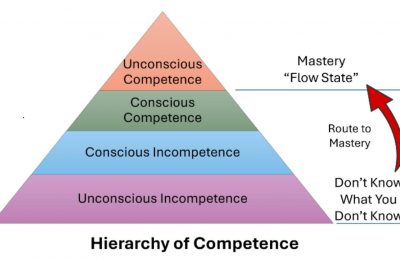
One Comment
Kol3ktor
September 16, 2025 at 7:55 amYour words have a layered texture. Meaning and feeling intertwine, encouraging repeated reading to uncover the richness beneath the surface.